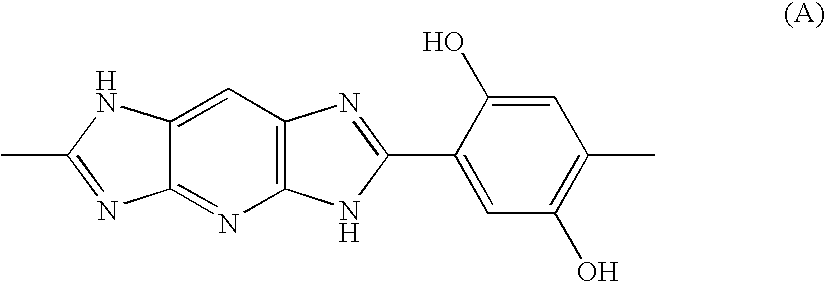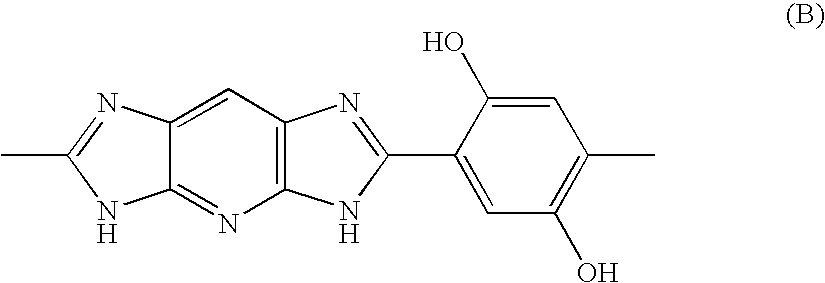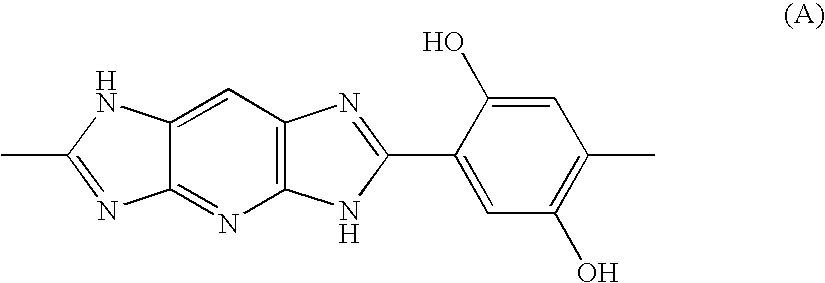Electrolytic Membrane
- Summary
- Abstract
- Description
- Claims
- Application Information
AI Technical Summary
Benefits of technology
Problems solved by technology
Method used
Image
Examples
referential example 1
Monomer Synthesis
[0070]17.772 Parts by weight of 2,3,5,6-tetraaminopyridine trihydrochloride monohydrate was dissolved in 100 parts by weight of water deaerated with nitrogen. 13.208 Parts by weight of 2,5-dihydroxyterephthalic acid was dissolved in 137 parts by weight of a 1M sodium hydroxide aqueous solution, followed by deaeration with nitrogen. The 2,3,5,6-tetraaminopyridine trihydrochloride monohydrate aqueous solution was dropwise added to the 2,5-dihydroxyterephthalic acid disodium salt aqueous solution over 10 minutes. Then, 24.3 parts by weight of polyphosphoric acid, 35 parts by weight of water deaerated with nitrogen and 1 part by weight of acetic acid were added, and the resultant salt was recovered by filtering and dispersed in, and mixed with, 3,000 parts by weight of water deaerated with nitrogen, followed by re-filtering. Procedures of the above dispersing / mixing and filtering were repeated 3 times to give 2,3,5,6-tetraaminopyridine / 2,5-dihydroxyterephthalaic acid sa...
referential example 2
[0071]62.54 Parts by weight of polyphosphoric acid and 14.76 parts by weight of phosphorus pentoxide were added to 22.88 parts by weight of the 2,3,5,6-tetraaminopyridine / 2,5-dihydroxyterephthalaic acid salt obtained in Referential Example 1, and they were stirred and mixed at 100° C. for 1 hour. Then, the mixture was temperature-increased to 140° C. while taking 2 hours, and at 140° C. it was stirred for 1 hour. Then, the reaction mixture was temperature-increased to 180° C. while taking 1 hour, and at 180° C. it was allowed to react for 5 hours to give a dope. The thus-obtained dope contained 18 parts by weight of a polymer and 82 parts by weight of polyphosphoric acid. When measured through a polarizing microscope, the dope exhibited crystallinity. The dope was re-precipitated in water and washed with water to give a polymer. The thus-obtained polymer had a reduced viscosity of 15 dl / g.
example 1
Preparation of Press Membrane
[0072]The dope obtained in Referential Example 2 was pressed at 200° C. with a heat-press machine while it was sandwiched between fluorine resin membranes, and the press product was washed with water to give a 100 μm thick membrane. Table 1 shows results of the ion conductivity measurement and oxidation resistance test of this membrane.
PUM
| Property | Measurement | Unit |
|---|---|---|
| Temperature | aaaaa | aaaaa |
| Temperature | aaaaa | aaaaa |
| Thickness | aaaaa | aaaaa |
Abstract
Description
Claims
Application Information
 Login to View More
Login to View More - R&D
- Intellectual Property
- Life Sciences
- Materials
- Tech Scout
- Unparalleled Data Quality
- Higher Quality Content
- 60% Fewer Hallucinations
Browse by: Latest US Patents, China's latest patents, Technical Efficacy Thesaurus, Application Domain, Technology Topic, Popular Technical Reports.
© 2025 PatSnap. All rights reserved.Legal|Privacy policy|Modern Slavery Act Transparency Statement|Sitemap|About US| Contact US: help@patsnap.com



